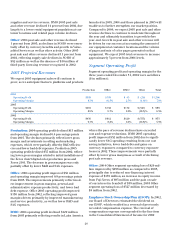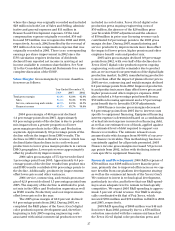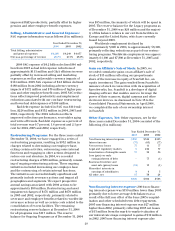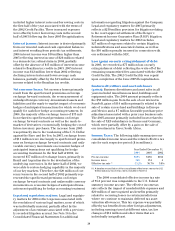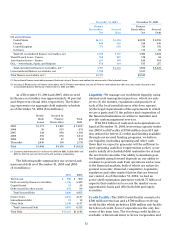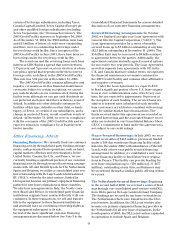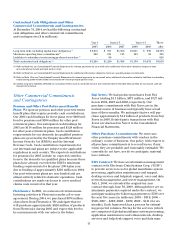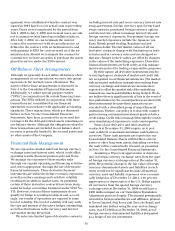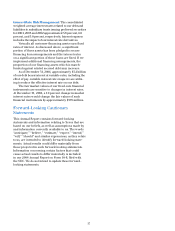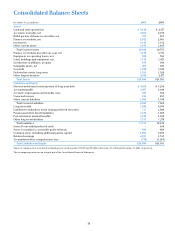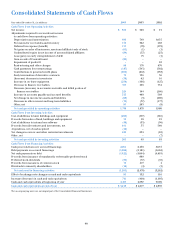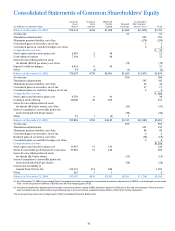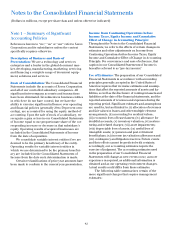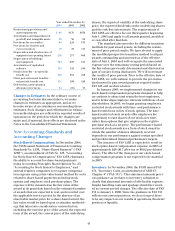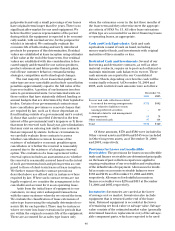Xerox 2004 Annual Report Download - page 38
Download and view the complete annual report
Please find page 38 of the 2004 Xerox annual report below. You can navigate through the pages in the report by either clicking on the pages listed below, or by using the keyword search tool below to find specific information within the annual report.
36
agement) were established when the contract was
signed in 1994 based on our actual costs in preceding
years. Prices were renegotiated for the period from
July 1, 2004 to July 1, 2009 and, in most cases, are sub-
ject to annual revision based upon inflation indices.
After July 1, 2006, we can terminate the current
contract for convenience with six months notice, as
defined in the contract, with no termination fee and
with payment to EDS for costs incurred as of the ter-
mination date. Should we terminate the contract for
convenience, we have an option to purchase the assets
placed in service under the EDS contract.
Off-Balance Sheet Arrangements
Although we generally do not utilize off-balance sheet
arrangements in our operations, we enter into operat-
ing leases in the normal course of business. The
nature of these lease arrangements is discussed in
Note 5 to the Consolidated Financial Statements.
Additionally, we utilize special purpose entities
(“SPEs”) in conjunction with certain financing trans-
actions. The SPEs utilized in conjunction with these
transactions are consolidated in our financial
statements in accordance with applicable accounting
standards. These transactions, which are discussed
further in Note 3 to the Consolidated Financial
Statements, havebeen accounted for as secured bor-
rowings with the debt and related assets remaining on
our balance sheets. Although the obligations related to
these transactions are included in our balance sheet,
recourse is generally limited to the secured assets and
no other assets of the Company.
Financial Risk Management
We are exposed to market risk from foreign currency
exchange rates and interest rates, which could affect
operating results, financial position and cash flows.
We manage our exposure to these market risks
through our regular operating and financing activities
and, when appropriate, through the use of derivative
financial instruments. These derivative financial
instruments are utilized to hedge economic exposures
as well as reduce earnings and cash flow volatility
resulting from shifts in market rates. As permitted,
certain of these derivativecontracts have been desig-
nated for hedge accounting treatment under SFAS No.
133. However, certain of these instruments do not
qualify for hedge accounting treatment and, accord-
ingly, our results of operations are exposed to some
level of volatility. The level of volatility will vary with
the type and amount of derivative hedges outstanding,
as well as fluctuations in the currency and interest
rate market during the period.
Weenter into limited types of derivative contracts,
including interest rate and cross currency interest rate
swap agreements, foreign currency spot, forward and
swap contracts, purchased foreign currency options
and interest rate collars to manage interest rate and
foreign currency exposures. Our primary foreign cur-
rency market exposures include the Japanese yen,
Euro, British pound sterling, Brazilian real and
Canadian dollar. The fair market values of all our
derivative contracts change with fluctuations in inter-
est rates and/or currency rates and are designed so
that any changes in their values are offset by changes
in the values of the underlying exposures. Derivative
financial instruments are held solely as risk manage-
ment tools and not for trading or speculative purposes.
By their nature, all derivative instruments involve,
to varying degrees, elements of market and credit risk
not recognized in our financial statements. The market
risk associated with these instruments resulting from
currency exchange and interest rate movements is
expected to offset the market risk of the underlying
transactions, assets and liabilities being hedged. We do
not believe there is significant risk of loss in the event of
non-performance by the counterparties associated with
these instruments because these transactions are
executed with adiversified group of major financial
institutions. Further, our policy is to deal with counter-
parties having a minimum investment-grade or better
credit rating. Credit risk is managed through the contin-
uous monitoring of exposures to such counterparties.
Some of our derivative and other material
contracts at December 31, 2004require us to post
cash collateral or maintain minimum cash balances
in escrow. These cash amounts are reported in our
Consolidated Balance Sheets within Other current
assets or other long-term assets, depending on when
the cash will be contractually released, as presented
in Note 1 to the Consolidated Financial Statements.
Assuming a 10 percent appreciation or deprecia-
tion in foreign currency exchange rates from the quot-
ed foreign currency exchange rates at December 31,
2004, the potential change in the fair value of foreign
currency-denominated assets and liabilities in each
entity would not be significant because all material
currency asset and liability exposures were economi-
cally hedged as of December 31, 2004. A 10 percent
appreciation or depreciation of the U.S. Dollar against
all currencies from the quoted foreign currency
exchange rates at December 31, 2004 would have a
$496 million impact on our Cumulative Translation
Adjustment portion of equity. The amount permanently
invested in foreign subsidiaries and affiliates, primari-
ly Xerox Limited, Fuji Xerox and Xerox do Brasil, and
translated into dollars using the year-end exchange
rates, was $5.0 billion at December 31, 2004, net of
foreign currency-denominated liabilities designated
as a hedge of our net investment.


